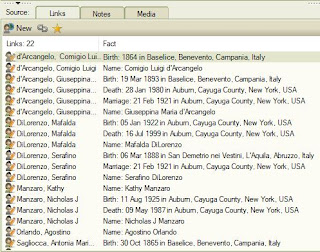How do you know when to stop gathering documents and facts for the in-laws in your family tree?
 |
| For certain types of distant relatives, I'm collecting the basic documents and stopping right there. |
I've been thinking about this ever since I decided to delete the in-laws of distant relatives from my tree.
Here's an example. When I was new at family history research, "easy" families were impossible to resist. So, when I saw my Great Uncle Mike's granddaughter-in-law had a tree with 7 generations of Uncle Mike's wife's family, I "adopted" them all.
I added this big branch to my tree with little or no documentation. I found documents for some of the people, but I didn't care enough about this branch to see it through. They weren't mine.
My new policy is simple. Unless I have a reason to go further, I will stop at the parents of a relative's spouse. I kept Uncle Mike's wife's parents, but the rest of her many ancestors are gone.
The 2 main reasons I would break this policy are:
- An in-law asked me to research their family.
- The in-law family is from the same town as mine and may be related.
With this new policy fresh on my mind, I found myself looking at documents for a relative's wife today. I downloaded Emily's naturalization papers from FindMyPast.com 2 weeks ago. They were offering free access for a few days.
The site had indexed Emily by her married name—my family name—which is why I found her. I recognized who she was immediately and downloaded the 2 pages. Then they sat on my desktop for a while.
When I finally examined the naturalization papers, I realized I had Emily's:
- date and place of birth in Italy
- immigration date with the name of the ship
The pages also confirm the birth dates I had for her husband and son, so they're well worth having.
Before I found her naturalization papers, all I had for Emily was:
- Her 1927 marriage certificate—but not a copy of it. I saw and transcribed it at the New York City Municipal Archives years ago. Her parents' names were on that marriage certificate, so I already had them in my tree.
- The 1940 U.S. Federal Census.
- The Social Security Death Index record of her death in 1991.
Knowing that I have no plans to add anyone else from her family, what other documents should I try to find and add to my tree?
Her naturalization papers say she was born on 2 Dec 1907 in Savignano, Italy. So I've got to look for that document. Vital records for Savignano are available online, so I drilled down to the year 1907 and found it.
This document gives me her mother's original name and her father's age and occupation. I don't need any more details about Emily's parents.
 |
| In 1907 Emily's town was called Savignano di Puglia. She was born on Via San Giovanni. |
Oh, by the way, her name isn't Emily. I always thought it might be Emilia, but now I have her birth record. She was born Ermilinda Franceschina Concettina D'Apice. She signed her marriage certificate as Emily, and her naturalization papers say Emily. But those papers also include the name "Ermelinda".
Now I have Emily's:
- 1907 birth in Italy
- 1927 marriage in New York
- 1940 census in New York
- 1944 naturalization in New York
- 1991 death in New York
What's the most important piece of documentation missing from that list? She was born in Italy and married in New York. How did she come to America, and with whom?
 |
| Emily and her sister Giuseppa came to New York in 1919 to join their sister Elvira in the Bronx. |
Her naturalization papers include an immigration date of 19 Dec 1919 aboard the S.S. Duca D'Aosta.
When I found her ship manifest, she was single and sailing with her much older, unmarried sister, Giuseppa. They listed their father Angelo, so I knew they were the right family from Savignano. They were joining their other sister, Elvira, at 628 Morris Avenue in the Bronx.
 |
| Emily's street in Savignano still exists. It's always nice to get an idea of where the people in your family tree came from. |
I had to laugh when I saw that address, because if you were going there, you were bound to meet my relatives.
So now I've learned the names of 2 of Emily's sisters, the age of one of them and the address of the other. But I have a policy now. No unnecessary siblings of the spouse of a distant relative.
That's why Giuseppa and Elvira D'Apice will live in my tree only in Emily's immigration notes. Having a policy makes it much easier to deal with questionable situations like this. What I will add, because her husband and son belong to my family, is her 1930 census. And maybe I'll find her and her sisters in the 1920 census. But no more than that!
If you're a fan of Mel Brooks' movie "The Producers," you may recognize the phrase I will repeat when I'm tempted to add a wildly distant in-law to my family tree. "Be brutal! Be brutal!"
And speaking of trimming your family tree:
















